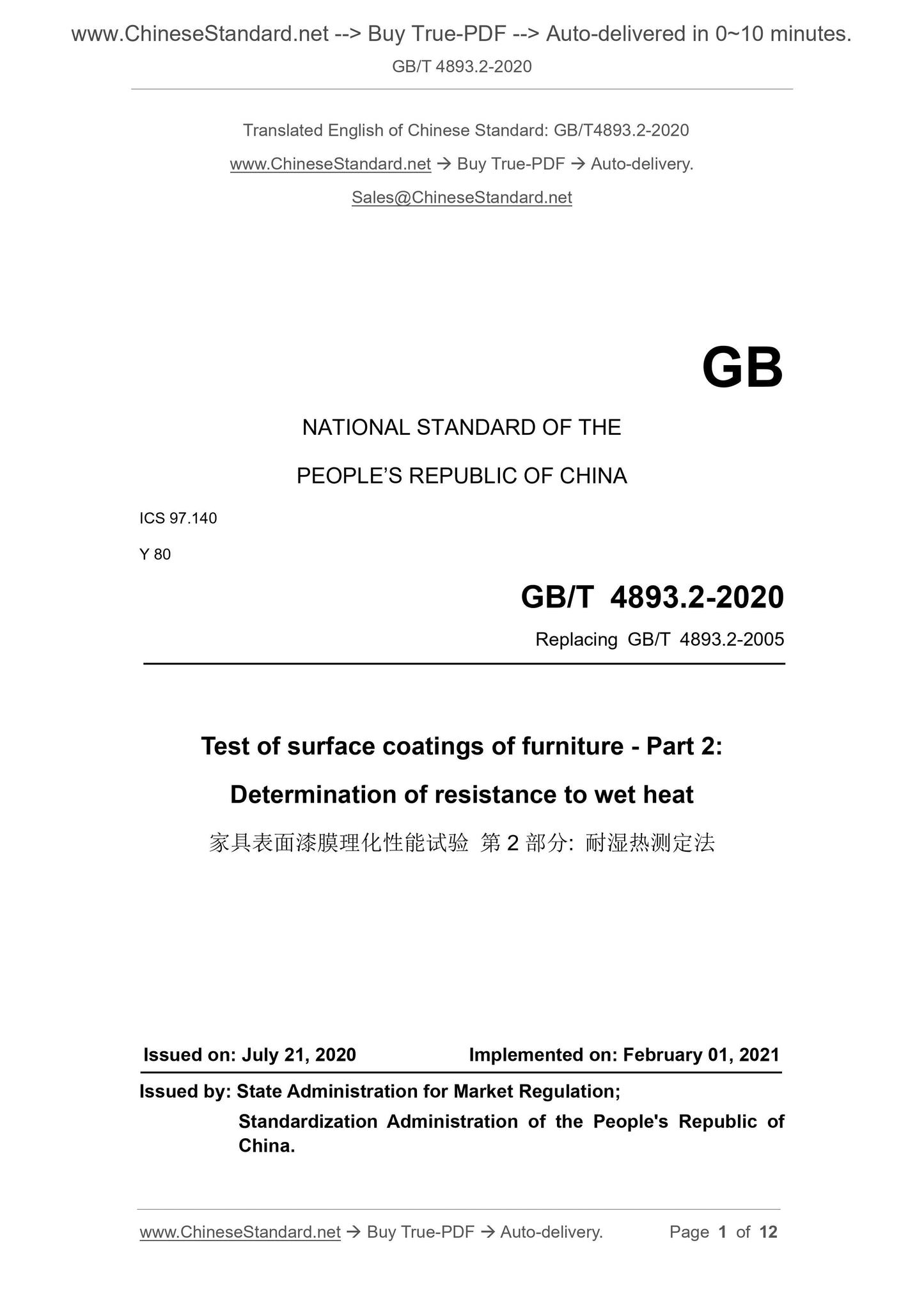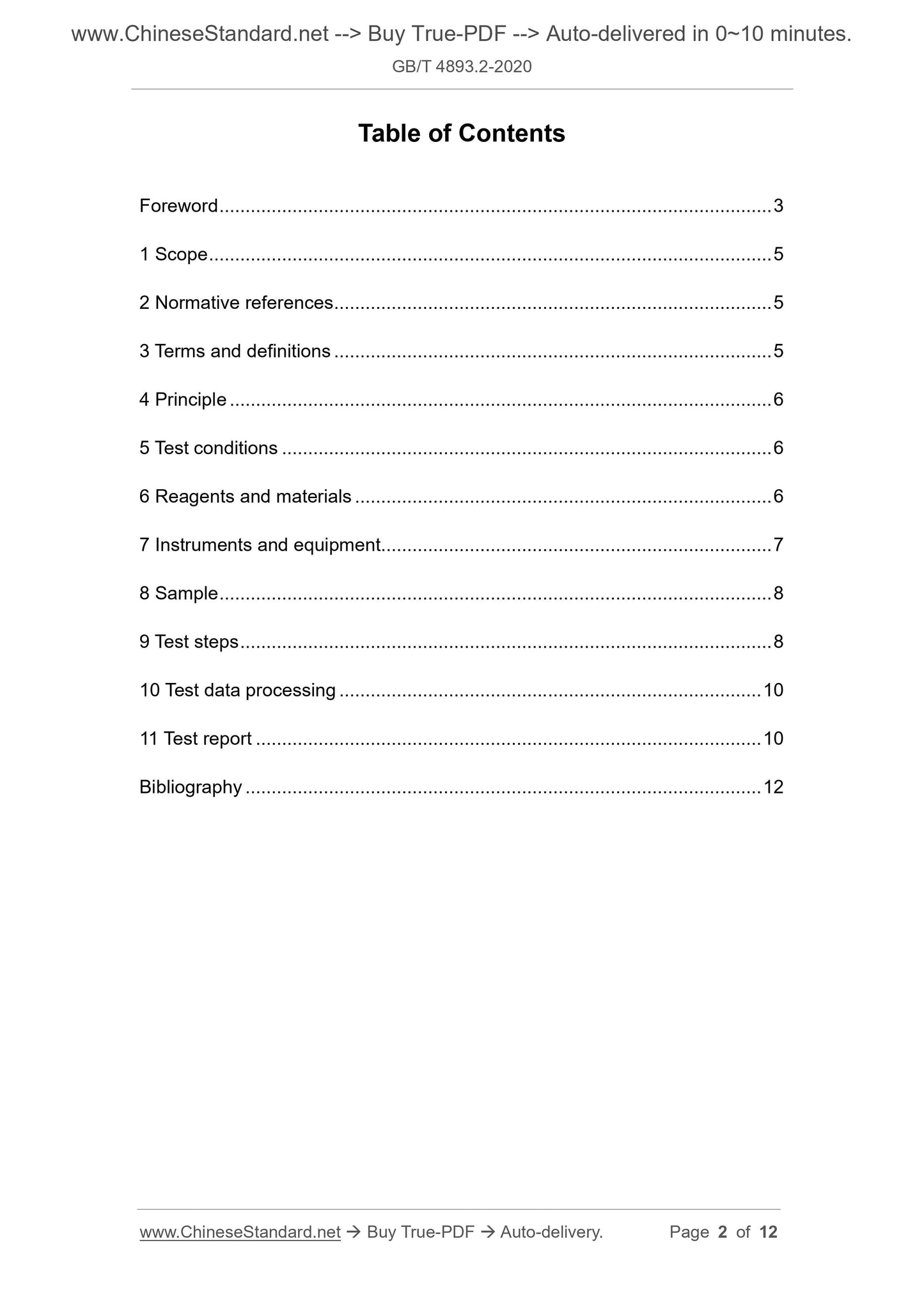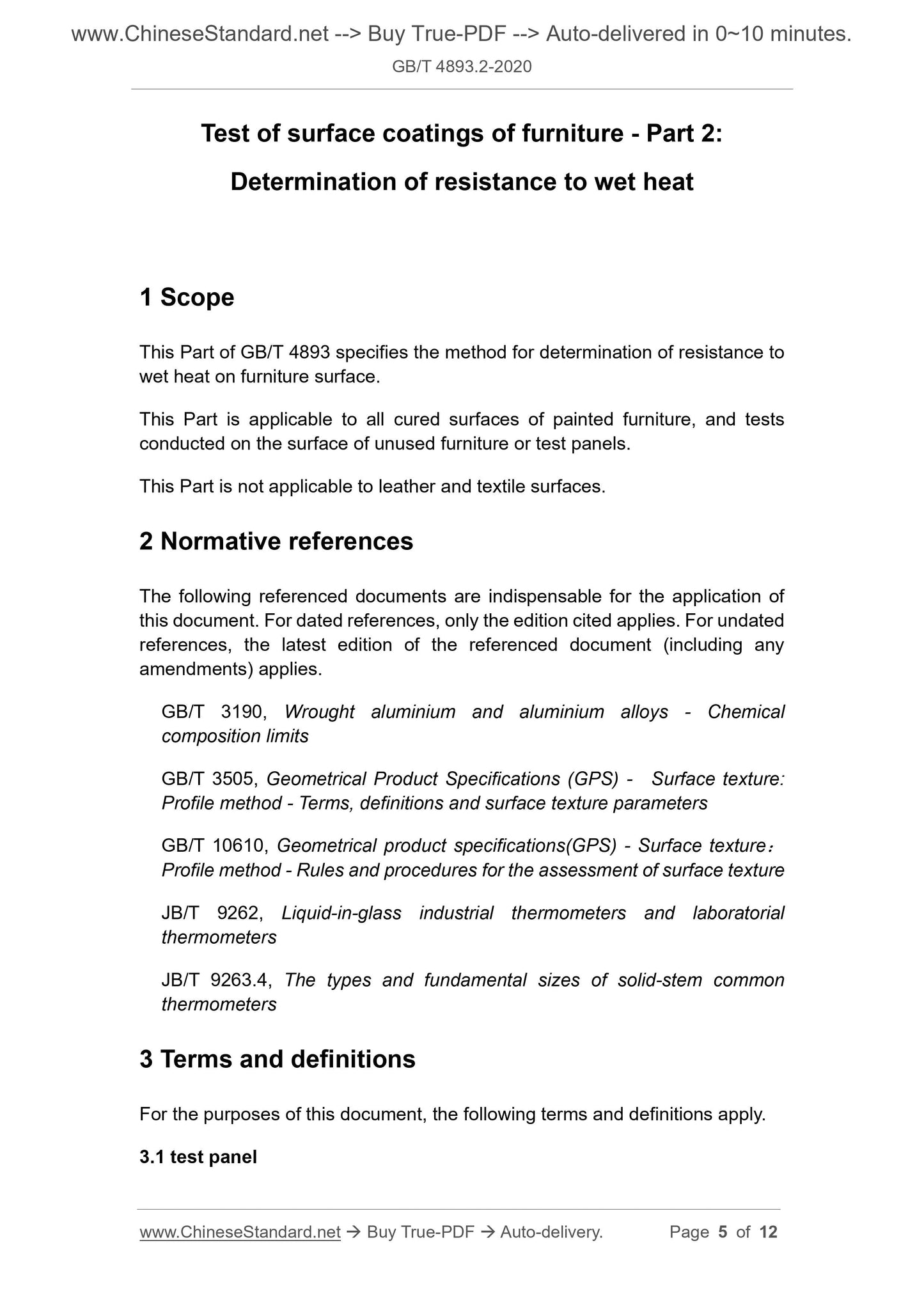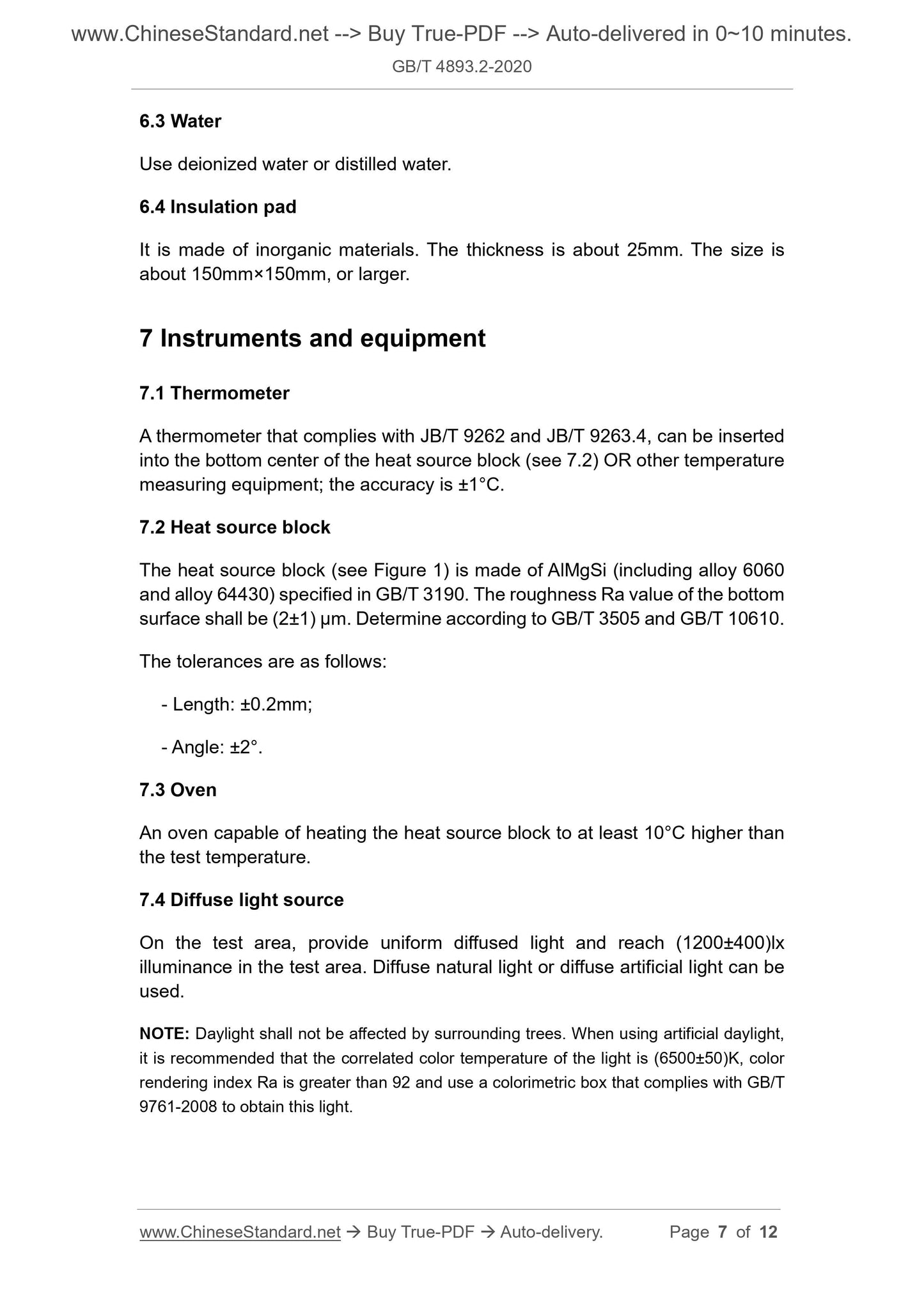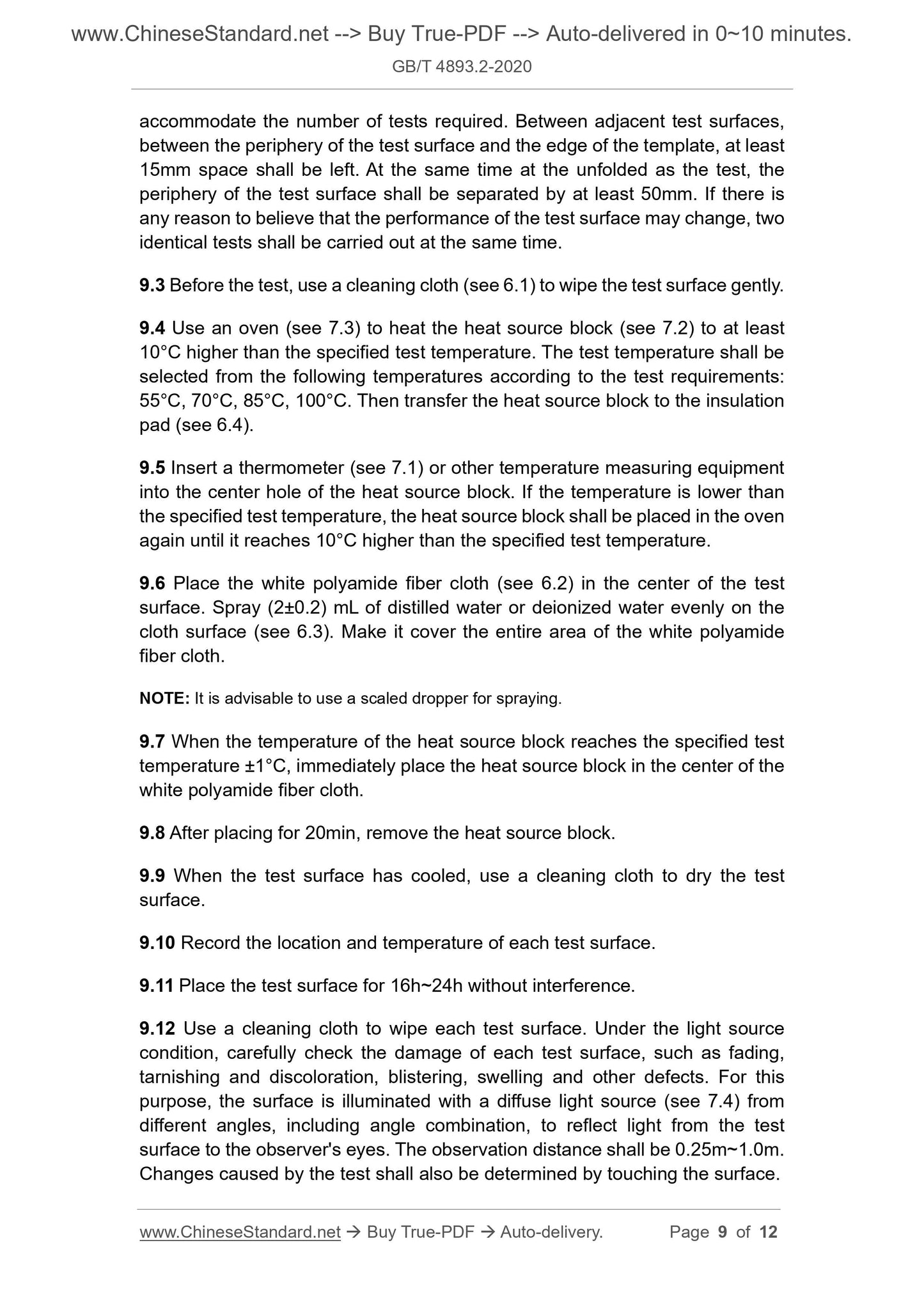1
/
of
5
www.ChineseStandard.us -- Field Test Asia Pte. Ltd.
GB/T 4893.2-2020 English PDF (GB/T4893.2-2020)
GB/T 4893.2-2020 English PDF (GB/T4893.2-2020)
Regular price
$170.00
Regular price
Sale price
$170.00
Unit price
/
per
Shipping calculated at checkout.
Couldn't load pickup availability
GB/T 4893.2-2020: Test of surface coatings of furniture - Part 2: Determination of resistance to wet heat
Delivery: 9 seconds. Download (& Email) true-PDF + Invoice.
Get Quotation: Click GB/T 4893.2-2020 (Self-service in 1-minute)
Historical versions (Master-website): GB/T 4893.2-2020
Preview True-PDF (Reload/Scroll-down if blank)
GB/T 4893.2-2020
GB
NATIONAL STANDARD OF THE
PEOPLE’S REPUBLIC OF CHINA
ICS 97.140
Y 80
Replacing GB/T 4893.2-2005
Test of surface coatings of furniture - Part 2:
Determination of resistance to wet heat
ISSUED ON: JULY 21, 2020
IMPLEMENTED ON: FEBRUARY 01, 2021
Issued by: State Administration for Market Regulation;
Standardization Administration of the People's Republic of
China.
Table of Contents
Foreword ... 3
1 Scope ... 5
2 Normative references ... 5
3 Terms and definitions ... 5
4 Principle ... 6
5 Test conditions ... 6
6 Reagents and materials ... 6
7 Instruments and equipment... 7
8 Sample ... 8
9 Test steps ... 8
10 Test data processing ... 10
11 Test report ... 10
Bibliography ... 12
Test of surface coatings of furniture - Part 2:
Determination of resistance to wet heat
1 Scope
This Part of GB/T 4893 specifies the method for determination of resistance to
wet heat on furniture surface.
This Part is applicable to all cured surfaces of painted furniture, and tests
conducted on the surface of unused furniture or test panels.
This Part is not applicable to leather and textile surfaces.
2 Normative references
The following referenced documents are indispensable for the application of
this document. For dated references, only the edition cited applies. For undated
references, the latest edition of the referenced document (including any
amendments) applies.
GB/T 3190, Wrought aluminium and aluminium alloys - Chemical
composition limits
GB/T 3505, Geometrical Product Specifications (GPS) - Surface texture:
Profile method - Terms, definitions and surface texture parameters
GB/T 10610, Geometrical product specifications(GPS) - Surface texture:
Profile method - Rules and procedures for the assessment of surface texture
JB/T 9262, Liquid-in-glass industrial thermometers and laboratorial
thermometers
JB/T 9263.4, The types and fundamental sizes of solid-stem common
thermometers
3 Terms and definitions
For the purposes of this document, the following terms and definitions apply.
3.1 test panel
6.3 Water
Use deionized water or distilled water.
6.4 Insulation pad
It is made of inorganic materials. The thickness is about 25mm. The size is
about 150mm×150mm, or larger.
7 Instruments and equipment
7.1 Thermometer
A thermometer that complies with JB/T 9262 and JB/T 9263.4, can be inserted
into the bottom center of the heat source block (see 7.2) OR other temperature
measuring equipment; the accuracy is ±1°C.
7.2 Heat source block
The heat source block (see Figure 1) is made of AlMgSi (including alloy 6060
and alloy 64430) specified in GB/T 3190. The roughness Ra value of the bottom
surface shall be (2±1) μm. Determine according to GB/T 3505 and GB/T 10610.
The tolerances are as follows:
- Length: ±0.2mm;
- Angle: ±2°.
7.3 Oven
An oven capable of heating the heat source block to at least 10°C higher than
the test temperature.
7.4 Diffuse light source
On the test area, provide uniform diffused light and reach (1200±400)lx
illuminance in the test area. Diffuse natural light or diffuse artificial light can be
used.
NOTE: Daylight shall not be affected by surrounding trees. When using artificial daylight,
it is recommended that the correlated color temperature of the light is (6500±50)K, color
rendering index Ra is greater than 92 and use a colorimetric box that complies with GB/T
9761-2008 to obtain this light.
accommodate the number of tests required. Between adjacent test surfaces,
between the periphery of the test surface and the edge of the template, at least
15mm space shall be left. At the same time at the unfolded as the test, the
periphery of the test surface shall be separated by at least 50mm. If there is
any reason to believe that the performance of the test surface may change, two
identical tests shall be carried out at the same time.
9.3 Before the test, use a cleaning cloth (see 6.1) to wipe the test surface gently.
9.4 Use an oven (see 7.3) to heat the heat source block (see 7.2) to at least
10°C higher than the specified test temperature. The test temperature shall be
selected from the following temperatures according to the test requirements:
55°C, 70°C, 85°C, 100°C. Then transfer the heat source block to the insulation
pad (see 6.4).
9.5 Insert a thermometer (see 7.1) or other temperature measuring equipment
into the center hole of the heat source block. If the temperature is lower than
the specified test temperature, the heat source block shall be placed in the oven
again until it reaches 10°C higher than the specified test temperature.
9.6 Place the white polyamide fiber cloth (see 6.2) in the center of the test
surface. Spray (2±0.2) mL of distilled water or deionized water evenly on the
cloth surface (see 6.3). Make it cover the entire area of the white polyamide
fiber cloth.
NOTE: It is advisable to use a scaled dropper for spraying.
9.7 When the temperature of the heat source block reaches the specified test
temperature ±1°C, immediately place the heat source block in the center of the
white polyamide fiber cloth.
9.8 After placing for 20min, remove the heat source block.
9.9 When the test surface has cooled, use a cleaning cloth to dry the test
surface.
9.10 Record the location and temperature of each test surface.
9.11 Place the test surface for 16h~24h without interference.
9.12 Use a cleaning cloth to wipe each test surface. Under the light source
condition, carefully check the damage of each test surface, such as fading,
tarnishing and discoloration, blistering, swelling and other defects. For this
purpose, the surface is illuminated with a diffuse light source (see 7.4) from
different angles, including angle combination, to reflect light from the test
surface to the observer's eyes. The observation distance shall be 0.25m~1.0m.
Changes caused by the test shall also be determined by touching the surface.
GB/T 4893.2-2020
GB
NATIONAL STANDARD OF THE
PEOPLE’S REPUBLIC OF CHINA
ICS 97.140
Y 80
Replacing GB/T 4893.2-2005
Test of surface coatings of furniture - Part 2:
Determination of resistance to wet heat
ISSUED ON: JULY 21, 2020
IMPLEMENTED ON: FEBRUARY 01, 2021
Issued by: State Administration for Market Regulation;
Standardization Administration of the People's Republic of
China.
Table of Contents
Foreword ... 3
1 Scope ... 5
2 Normative references ... 5
3 Terms and definitions ... 5
4 Principle ... 6
5 Test conditions ... 6
6 Reagents and materials ... 6
7 Instruments and equipment... 7
8 Sample ... 8
9 Test steps ... 8
10 Test data processing ... 10
11 Test report ... 10
Bibliography ... 12
Test of surface coatings of furniture - Part 2:
Determination of resistance to wet heat
1 Scope
This Part of GB/T 4893 specifies the method for determination of resistance to
wet heat on furniture surface.
This Part is applicable to all cured surfaces of painted furniture, and tests
conducted on the surface of unused furniture or test panels.
This Part is not applicable to leather and textile surfaces.
2 Normative references
The following referenced documents are indispensable for the application of
this document. For dated references, only the edition cited applies. For undated
references, the latest edition of the referenced document (including any
amendments) applies.
GB/T 3190, Wrought aluminium and aluminium alloys - Chemical
composition limits
GB/T 3505, Geometrical Product Specifications (GPS) - Surface texture:
Profile method - Terms, definitions and surface texture parameters
GB/T 10610, Geometrical product specifications(GPS) - Surface texture:
Profile method - Rules and procedures for the assessment of surface texture
JB/T 9262, Liquid-in-glass industrial thermometers and laboratorial
thermometers
JB/T 9263.4, The types and fundamental sizes of solid-stem common
thermometers
3 Terms and definitions
For the purposes of this document, the following terms and definitions apply.
3.1 test panel
6.3 Water
Use deionized water or distilled water.
6.4 Insulation pad
It is made of inorganic materials. The thickness is about 25mm. The size is
about 150mm×150mm, or larger.
7 Instruments and equipment
7.1 Thermometer
A thermometer that complies with JB/T 9262 and JB/T 9263.4, can be inserted
into the bottom center of the heat source block (see 7.2) OR other temperature
measuring equipment; the accuracy is ±1°C.
7.2 Heat source block
The heat source block (see Figure 1) is made of AlMgSi (including alloy 6060
and alloy 64430) specified in GB/T 3190. The roughness Ra value of the bottom
surface shall be (2±1) μm. Determine according to GB/T 3505 and GB/T 10610.
The tolerances are as follows:
- Length: ±0.2mm;
- Angle: ±2°.
7.3 Oven
An oven capable of heating the heat source block to at least 10°C higher than
the test temperature.
7.4 Diffuse light source
On the test area, provide uniform diffused light and reach (1200±400)lx
illuminance in the test area. Diffuse natural light or diffuse artificial light can be
used.
NOTE: Daylight shall not be affected by surrounding trees. When using artificial daylight,
it is recommended that the correlated color temperature of the light is (6500±50)K, color
rendering index Ra is greater than 92 and use a colorimetric box that complies with GB/T
9761-2008 to obtain this light.
accommodate the number of tests required. Between adjacent test surfaces,
between the periphery of the test surface and the edge of the template, at least
15mm space shall be left. At the same time at the unfolded as the test, the
periphery of the test surface shall be separated by at least 50mm. If there is
any reason to believe that the performance of the test surface may change, two
identical tests shall be carried out at the same time.
9.3 Before the test, use a cleaning cloth (see 6.1) to wipe the test surface gently.
9.4 Use an oven (see 7.3) to heat the heat source block (see 7.2) to at least
10°C higher than the specified test temperature. The test temperature shall be
selected from the following temperatures according to the test requirements:
55°C, 70°C, 85°C, 100°C. Then transfer the heat source block to the insulation
pad (see 6.4).
9.5 Insert a thermometer (see 7.1) or other temperature measuring equipment
into the center hole of the heat source block. If the temperature is lower than
the specified test temperature, the heat source block shall be placed in the oven
again until it reaches 10°C higher than the specified test temperature.
9.6 Place the white polyamide fiber cloth (see 6.2) in the center of the test
surface. Spray (2±0.2) mL of distilled water or deionized water evenly on the
cloth surface (see 6.3). Make it cover the entire area of the white polyamide
fiber cloth.
NOTE: It is advisable to use a scaled dropper for spraying.
9.7 When the temperature of the heat source block reaches the specified test
temperature ±1°C, immediately place the heat source block in the center of the
white polyamide fiber cloth.
9.8 After placing for 20min, remove the heat source block.
9.9 When the test surface has cooled, use a cleaning cloth to dry the test
surface.
9.10 Record the location and temperature of each test surface.
9.11 Place the test surface for 16h~24h without interference.
9.12 Use a cleaning cloth to wipe each test surface. Under the light source
condition, carefully check the damage of each test surface, such as fading,
tarnishing and discoloration, blistering, swelling and other defects. For this
purpose, the surface is illuminated with a diffuse light source (see 7.4) from
different angles, including angle combination, to reflect light from the test
surface to the observer's eyes. The observation distance shall be 0.25m~1.0m.
Changes caused by the test shall also be determined by touching the surface.
Delivery: 9 seconds. Download (& Email) true-PDF + Invoice.
Get Quotation: Click GB/T 4893.2-2020 (Self-service in 1-minute)
Historical versions (Master-website): GB/T 4893.2-2020
Preview True-PDF (Reload/Scroll-down if blank)
GB/T 4893.2-2020
GB
NATIONAL STANDARD OF THE
PEOPLE’S REPUBLIC OF CHINA
ICS 97.140
Y 80
Replacing GB/T 4893.2-2005
Test of surface coatings of furniture - Part 2:
Determination of resistance to wet heat
ISSUED ON: JULY 21, 2020
IMPLEMENTED ON: FEBRUARY 01, 2021
Issued by: State Administration for Market Regulation;
Standardization Administration of the People's Republic of
China.
Table of Contents
Foreword ... 3
1 Scope ... 5
2 Normative references ... 5
3 Terms and definitions ... 5
4 Principle ... 6
5 Test conditions ... 6
6 Reagents and materials ... 6
7 Instruments and equipment... 7
8 Sample ... 8
9 Test steps ... 8
10 Test data processing ... 10
11 Test report ... 10
Bibliography ... 12
Test of surface coatings of furniture - Part 2:
Determination of resistance to wet heat
1 Scope
This Part of GB/T 4893 specifies the method for determination of resistance to
wet heat on furniture surface.
This Part is applicable to all cured surfaces of painted furniture, and tests
conducted on the surface of unused furniture or test panels.
This Part is not applicable to leather and textile surfaces.
2 Normative references
The following referenced documents are indispensable for the application of
this document. For dated references, only the edition cited applies. For undated
references, the latest edition of the referenced document (including any
amendments) applies.
GB/T 3190, Wrought aluminium and aluminium alloys - Chemical
composition limits
GB/T 3505, Geometrical Product Specifications (GPS) - Surface texture:
Profile method - Terms, definitions and surface texture parameters
GB/T 10610, Geometrical product specifications(GPS) - Surface texture:
Profile method - Rules and procedures for the assessment of surface texture
JB/T 9262, Liquid-in-glass industrial thermometers and laboratorial
thermometers
JB/T 9263.4, The types and fundamental sizes of solid-stem common
thermometers
3 Terms and definitions
For the purposes of this document, the following terms and definitions apply.
3.1 test panel
6.3 Water
Use deionized water or distilled water.
6.4 Insulation pad
It is made of inorganic materials. The thickness is about 25mm. The size is
about 150mm×150mm, or larger.
7 Instruments and equipment
7.1 Thermometer
A thermometer that complies with JB/T 9262 and JB/T 9263.4, can be inserted
into the bottom center of the heat source block (see 7.2) OR other temperature
measuring equipment; the accuracy is ±1°C.
7.2 Heat source block
The heat source block (see Figure 1) is made of AlMgSi (including alloy 6060
and alloy 64430) specified in GB/T 3190. The roughness Ra value of the bottom
surface shall be (2±1) μm. Determine according to GB/T 3505 and GB/T 10610.
The tolerances are as follows:
- Length: ±0.2mm;
- Angle: ±2°.
7.3 Oven
An oven capable of heating the heat source block to at least 10°C higher than
the test temperature.
7.4 Diffuse light source
On the test area, provide uniform diffused light and reach (1200±400)lx
illuminance in the test area. Diffuse natural light or diffuse artificial light can be
used.
NOTE: Daylight shall not be affected by surrounding trees. When using artificial daylight,
it is recommended that the correlated color temperature of the light is (6500±50)K, color
rendering index Ra is greater than 92 and use a colorimetric box that complies with GB/T
9761-2008 to obtain this light.
accommodate the number of tests required. Between adjacent test surfaces,
between the periphery of the test surface and the edge of the template, at least
15mm space shall be left. At the same time at the unfolded as the test, the
periphery of the test surface shall be separated by at least 50mm. If there is
any reason to believe that the performance of the test surface may change, two
identical tests shall be carried out at the same time.
9.3 Before the test, use a cleaning cloth (see 6.1) to wipe the test surface gently.
9.4 Use an oven (see 7.3) to heat the heat source block (see 7.2) to at least
10°C higher than the specified test temperature. The test temperature shall be
selected from the following temperatures according to the test requirements:
55°C, 70°C, 85°C, 100°C. Then transfer the heat source block to the insulation
pad (see 6.4).
9.5 Insert a thermometer (see 7.1) or other temperature measuring equipment
into the center hole of the heat source block. If the temperature is lower than
the specified test temperature, the heat source block shall be placed in the oven
again until it reaches 10°C higher than the specified test temperature.
9.6 Place the white polyamide fiber cloth (see 6.2) in the center of the test
surface. Spray (2±0.2) mL of distilled water or deionized water evenly on the
cloth surface (see 6.3). Make it cover the entire area of the white polyamide
fiber cloth.
NOTE: It is advisable to use a scaled dropper for spraying.
9.7 When the temperature of the heat source block reaches the specified test
temperature ±1°C, immediately place the heat source block in the center of the
white polyamide fiber cloth.
9.8 After placing for 20min, remove the heat source block.
9.9 When the test surface has cooled, use a cleaning cloth to dry the test
surface.
9.10 Record the location and temperature of each test surface.
9.11 Place the test surface for 16h~24h without interference.
9.12 Use a cleaning cloth to wipe each test surface. Under the light source
condition, carefully check the damage of each test surface, such as fading,
tarnishing and discoloration, blistering, swelling and other defects. For this
purpose, the surface is illuminated with a diffuse light source (see 7.4) from
different angles, including angle combination, to reflect light from the test
surface to the observer's eyes. The observation distance shall be 0.25m~1.0m.
Changes caused by the test shall also be determined by touching the surface.
GB/T 4893.2-2020
GB
NATIONAL STANDARD OF THE
PEOPLE’S REPUBLIC OF CHINA
ICS 97.140
Y 80
Replacing GB/T 4893.2-2005
Test of surface coatings of furniture - Part 2:
Determination of resistance to wet heat
ISSUED ON: JULY 21, 2020
IMPLEMENTED ON: FEBRUARY 01, 2021
Issued by: State Administration for Market Regulation;
Standardization Administration of the People's Republic of
China.
Table of Contents
Foreword ... 3
1 Scope ... 5
2 Normative references ... 5
3 Terms and definitions ... 5
4 Principle ... 6
5 Test conditions ... 6
6 Reagents and materials ... 6
7 Instruments and equipment... 7
8 Sample ... 8
9 Test steps ... 8
10 Test data processing ... 10
11 Test report ... 10
Bibliography ... 12
Test of surface coatings of furniture - Part 2:
Determination of resistance to wet heat
1 Scope
This Part of GB/T 4893 specifies the method for determination of resistance to
wet heat on furniture surface.
This Part is applicable to all cured surfaces of painted furniture, and tests
conducted on the surface of unused furniture or test panels.
This Part is not applicable to leather and textile surfaces.
2 Normative references
The following referenced documents are indispensable for the application of
this document. For dated references, only the edition cited applies. For undated
references, the latest edition of the referenced document (including any
amendments) applies.
GB/T 3190, Wrought aluminium and aluminium alloys - Chemical
composition limits
GB/T 3505, Geometrical Product Specifications (GPS) - Surface texture:
Profile method - Terms, definitions and surface texture parameters
GB/T 10610, Geometrical product specifications(GPS) - Surface texture:
Profile method - Rules and procedures for the assessment of surface texture
JB/T 9262, Liquid-in-glass industrial thermometers and laboratorial
thermometers
JB/T 9263.4, The types and fundamental sizes of solid-stem common
thermometers
3 Terms and definitions
For the purposes of this document, the following terms and definitions apply.
3.1 test panel
6.3 Water
Use deionized water or distilled water.
6.4 Insulation pad
It is made of inorganic materials. The thickness is about 25mm. The size is
about 150mm×150mm, or larger.
7 Instruments and equipment
7.1 Thermometer
A thermometer that complies with JB/T 9262 and JB/T 9263.4, can be inserted
into the bottom center of the heat source block (see 7.2) OR other temperature
measuring equipment; the accuracy is ±1°C.
7.2 Heat source block
The heat source block (see Figure 1) is made of AlMgSi (including alloy 6060
and alloy 64430) specified in GB/T 3190. The roughness Ra value of the bottom
surface shall be (2±1) μm. Determine according to GB/T 3505 and GB/T 10610.
The tolerances are as follows:
- Length: ±0.2mm;
- Angle: ±2°.
7.3 Oven
An oven capable of heating the heat source block to at least 10°C higher than
the test temperature.
7.4 Diffuse light source
On the test area, provide uniform diffused light and reach (1200±400)lx
illuminance in the test area. Diffuse natural light or diffuse artificial light can be
used.
NOTE: Daylight shall not be affected by surrounding trees. When using artificial daylight,
it is recommended that the correlated color temperature of the light is (6500±50)K, color
rendering index Ra is greater than 92 and use a colorimetric box that complies with GB/T
9761-2008 to obtain this light.
accommodate the number of tests required. Between adjacent test surfaces,
between the periphery of the test surface and the edge of the template, at least
15mm space shall be left. At the same time at the unfolded as the test, the
periphery of the test surface shall be separated by at least 50mm. If there is
any reason to believe that the performance of the test surface may change, two
identical tests shall be carried out at the same time.
9.3 Before the test, use a cleaning cloth (see 6.1) to wipe the test surface gently.
9.4 Use an oven (see 7.3) to heat the heat source block (see 7.2) to at least
10°C higher than the specified test temperature. The test temperature shall be
selected from the following temperatures according to the test requirements:
55°C, 70°C, 85°C, 100°C. Then transfer the heat source block to the insulation
pad (see 6.4).
9.5 Insert a thermometer (see 7.1) or other temperature measuring equipment
into the center hole of the heat source block. If the temperature is lower than
the specified test temperature, the heat source block shall be placed in the oven
again until it reaches 10°C higher than the specified test temperature.
9.6 Place the white polyamide fiber cloth (see 6.2) in the center of the test
surface. Spray (2±0.2) mL of distilled water or deionized water evenly on the
cloth surface (see 6.3). Make it cover the entire area of the white polyamide
fiber cloth.
NOTE: It is advisable to use a scaled dropper for spraying.
9.7 When the temperature of the heat source block reaches the specified test
temperature ±1°C, immediately place the heat source block in the center of the
white polyamide fiber cloth.
9.8 After placing for 20min, remove the heat source block.
9.9 When the test surface has cooled, use a cleaning cloth to dry the test
surface.
9.10 Record the location and temperature of each test surface.
9.11 Place the test surface for 16h~24h without interference.
9.12 Use a cleaning cloth to wipe each test surface. Under the light source
condition, carefully check the damage of each test surface, such as fading,
tarnishing and discoloration, blistering, swelling and other defects. For this
purpose, the surface is illuminated with a diffuse light source (see 7.4) from
different angles, including angle combination, to reflect light from the test
surface to the observer's eyes. The observation distance shall be 0.25m~1.0m.
Changes caused by the test shall also be determined by touching the surface.
Share
